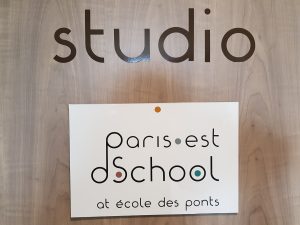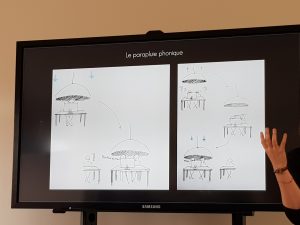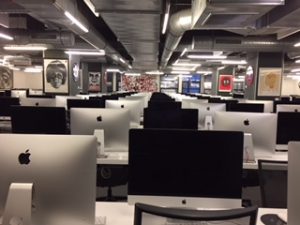Blog of the TU/e’s visit to Paris by Birgit Pepin, 4TU.CEE leader TU/e
On the 2nd November 2017 a delegation of five colleagues (and two students) from different TU/e departments and disciplines, all belonging or interested in the Innovation Space at TU/e, visited two tertiary institutions/schools/universities in Paris, which are known to be “different” in terms of their teaching and learning practices. And indeed the two schools could not be more different from each other!
d.school
In the morning of the 2nd November we visited d.school, situated at the Universite Paris-Est Marne-la-Vallee. This school initially started when the Ministry of Education and Research brought out a call for projects under the IDEFI (Excellence Initiatives for Innovative Education) framework.

d.school
——————————
The French school system
On a side note, you probably know that France has this system of Grandes Ecoles and Polytechniques: these are elite schools that are very difficult to get into. For example, to get into the elite schools for engineering, students prepare for two years in special courses (cours preparatoires) after which they have to pass the concours (entrance examination) to get accepted in one of these Grandes Ecoles. During these two years of preparation for the concours, students typically work 60-80 hours per week, on high level mathematics and science topic areas. They sometimes call these students ‘moles’ (mollen in Dutch), to illustrate that they only occasionally come up to the surface (from their intense studies) to gasp some air! Once they have passed the entrance examination/concours successfully, they are admitted to the elite school where they study engineering for another three years (which is said to be ‘easy’ after the two years of extremely hard work). The students from these elite schools have no problem to find jobs; they belong to the elite of the country – “la haute couture” as our guide put it.
——————————————————————————————————————————————————
In the case of d.school, several partners (École des Ponts ParisTech, ENSAVT, UPEMLV, ESIEE Paris and EIVP) joined forces to establish the French d.school, equal to (or above?) international standards and sharing an outlook with Europe’s Living Labs. The goal of d.school is to act as a role model for innovative and future educational approaches, with the aim of inspiring a new generation of training programs in breakthrough innovation, through new methods drawing on design thinking, like those established at Stanford University (USA).
For d.school Stanford was the example, as the Mecca of innovators, as the source of inspiration par excellence. And it was also the place where the d.school was born, after its founder (Hasso Plattner) became convinced of the importance of making design thinking an official academic subject. There are two other ‘sister’ schools to d.school: one at Stanford University, the other in Potsdam (both set up in 2005). Their ambitions are the following:
– to train future innovators to be “thinkers” and “makers” of breakthroughs
– to use design thinking to inspire multidisciplinary teams
– to foster radical alliances between students, teachers and industry
– to tackle big projects and use prototyping to discover new solutions.
On their website we can read:
“d.school, situated within the Ecole des Ponts ParisTech, aims to discover the richness of innovation through the culture of design thinking. Engineers, architects, designers, urban planners, or students of any other discipline, if you want to learn innovation by practicing it, this school is for you! (our translation)
Student project presentations
During our visit we could participate in several of the students’ project presentations. These were presented, and students typically also worked, in particular design spaces (housed at the École des Ponts), also called ‘studios’ (linking to the industrial design tradition inherited from the Arts & Crafts movement). In comparison, the Silicon Valley/Stanford tradition has the myth of the “garage” space, where the designer/inventor typically develops his prototype and runs the first technical feasibility tests on his idea. In the d.schools context, our guide also spoke of “loft” spaces: an open space with a very high ceiling, housing as many as a dozen teams. D.school now has 300 m² with access to a 400 m² prototyping room, eight classrooms and a lecture hall in a new, highly innovative positive energy building. It is said that this layout is to create a changed mindset compared with conventional workspaces; a mindset that fosters innovation, exploration, experimentation.

presentation of student projec
Talking to a group of students (working on a project of finding new ways of mobility/wheelchairs) at d.school, it was clear that these students not only had the cognitive skills (probably acquired during their 4-5 years of rigorous Grandes Ecoles studies), but could also combine this with their social and entrepreneurial skills: they had to find financial funding and support for their project, and had to disseminate and sell the final product too. Indeed, the capacity to mobilize the key players must be triggered from the start by communication initiatives, termed “dissemination”. The students we talked to wanted to do something different than the traditional engineering studies, and they wanted to be given the space to develop their skills and potential – “Innovation- the fruit of passion” as a slogan of one of their conferences (in Bretagne in this case).
«Design thinking can be described as a discipline that uses the designer’s sensibility and methods to match people’s needs with what is technologically feasible and what a viable business strategy can convert into customer value and market opportunity.»
Tim Brown, CEO of IDEO, HBR, 2009
Ecole 42
In the afternoon of the 2nd November, our group went to visit another very different school: a school/university that admits everybody – no examination results needed to get in! After ‘la haute couture’ at d.school, we met students who had not passed a single school examination. Moreover, this university has no teachers, syllabus or fees – they say that Paris’s École 42 is reinventing education for the future! And more than that: this free, teacher-less university is (apparently) schooling thousands of “future-proof programmers”, who have no problems to find jobs in France’s high tech industry- something that they have in common with their ‘colleagues’ from d.school.
When we walked in, we had to wait some time at the reception. There is tight entry restrictions (not everybody can walk in from the street). The hall looks like a modern art hall: from colourful provocative street art, to a window that shows the main “computer/number crunching” machine, the hardware that feeds the computers in the school.
When our guide came, we could visit the whole place. It was like a village, where students live: places to rest, or sleep, bathrooms and showers, eating places, and … two huge floors full of big screens – iMacs as far as the eye can see! And students buzzing around the place: working, chatting, eating, resting, … working and helping each other: alone, with headphones, in pairs and groups—hovering around iMacs. No graffiti, no vandalism, no theft, although the school is open 24/7.

iMac room at Ecole 42
The guide told us that (unlike other school/universities where students have to provide degree certificates or skills tests to get in) here at Ecole 42 students have four weeks to prove that they can earn a place at the school: they have a four-week course, ‘la piscine’ (the swimming pool), which teaches and tests students on games-like tests. Once they have been accepted, they can study for three to five years, to come out as programming specialists: apparently, 80% of students get jobs before they finish the course; and 100% are employed by the end!
Early each morning students get digital assignments/projects to complete, and they have a certain time to complete them. This means that students are juggling projects all the time. Since there are no teachers, it is up to students to figure things out. Everything is graded by peers (and using the software). Students manage their own time (within limits of assessment, of course); they have to be self-organized. So, learning at École 42 is both project-based and peer-to-peer based.
The school is 100% merit based. Typically, we were told, approximately one third pass a basic online logic test to qualify for entry, but the school can only take a certain number per year, so only the top students are admitted to the ‘la piscine’. Approximately 3,000 then compete in pools of 1,000 for a month to see who best completes the digital projects (of ‘la piscine’); the top third of performers are then admitted. Of those, only 5-15% drop out during the course.
The curriculum is gamified and students work on digital projects; there are modules (e.g. tech integration, algorithms) and languages (e.g. Python, C, Java). Our guide also talked about the peer marking: if students want their projects corrected, they must spend “correction points” – these they earn by correcting someone else’s project.
Whilst schools and universities around the world are eager to find out what knowledge and skills students need to succeed and thrive in their lives future (in the Netherlands we discuss and often disagree about which knowledge and skills should be prioritized, and how they should be taught), here notions of problem-based learning, collaboration, creativity, critical thinking, communication, and initiative (or agency) seem to be at work. Not as a result, but this school seems to be set up with them in mind from the start.
The school is the brainchild of Xavier Niel, a French billionaire and serial entrepreneur. In 2013, he declared that France’s education system was broken and set out to “fix (one part of) it”. He wanted to address two problems: the lack of coding talent in France; and the perceived inequality surrounding the Grandes Ecoles, the elite universities and engineering schools. What he cares about, so they say, is logic and motivation. He thinks that programming is more art than science. The result of his vision, Ecole 42, is something unlike any other school in France, or elsewhere. Apparently, students are not taught, but they create “what they need”.
The two schools could not be more different! It is indeed difficult to bring to paper all the impressions and thoughts that one has on such an eye-opening tour.




